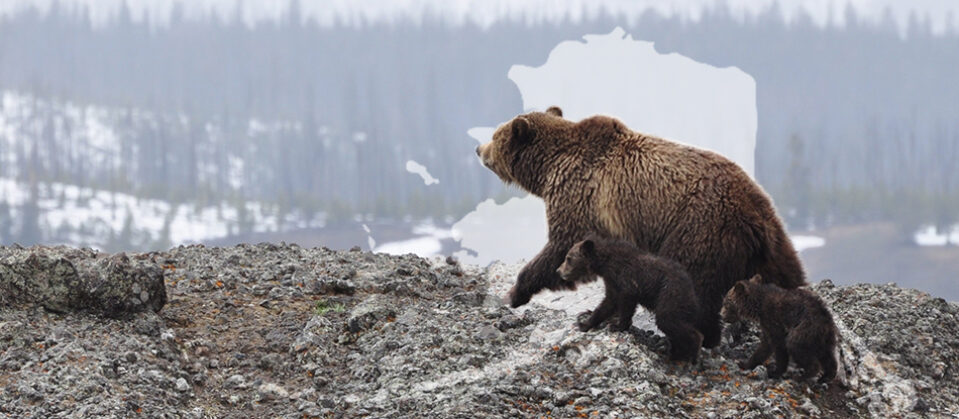When Our Forests Are Gone
Elizabeth Johnson Klein (Past Deputy Director) / August 20, 2020

In our imperfect union, states do not stand alone as islands disconnected from one another. What happens to the environment in one state can have profound impacts elsewhere. Unchecked air pollution from coal-fired power plants in one state can harm another state’s residents downwind. Destruction of a species’ critical habitat in one state can drive that species closer to extinction, ending migratory paths across the nation. And the unmitigated drive to develop fossil fuels in one state can have devastating climate change-related impacts all across the country, and indeed the world.
For these reasons, all states must understand how actions happening outside of their borders might impact the environment and health of their own residents. Take Alaska.
In recent months, the administration has moved to open up an unprecedented amount of Alaskan acreage to fossil fuel development, while at the same time removing protections for National Forest lands that could otherwise mitigate that development’s climate change-related impacts. Collectively, the administration’s plans for Alaska’s National Petroleum Reserve and the Coastal Plain of the Arctic National Wildlife Refuge would open up over 8 million acres of uniquely wild, undeveloped acreage to oil and gas leasing. At the same time, through its proposed Alaska roadless rule, the administration wants to remove environmental protections in the Tongass National Forest and open up over 9 million acres to new roadbuilding and logging activities.
State AGs from across the nation have been actively participating in the review processes for these proposals and, unfortunately, every single process suffers from the same callous disregard for the law’s requirements to sufficiently review the environmental consequences, including the very real impacts associated with unchecked increases in greenhouse gas emissions.
Far from viewing Alaska as a pretty snow globe on a shelf, state AGs recognize that these actions could have impacts far beyond Alaska’s borders. The AG coalition commenting on opening up the Arctic Refuge to fossil fuel development noted the deeply concerning climate change effects that the region is experiencing, including air temperatures increasing more than twice as fast as the global average, melting sea ice, increased boreal wildfires, and permafrost degradation. These are impacts that are coming to other regions around the world, and more fossil fuel development in Alaska will increase greenhouse gas emissions at the exact time that many states are fighting climate change by decreasing greenhouse gas emissions. The proposal for the Reserve alone could increase fossil fuel production by as much as seventy-five percent, “causing total lifetime emissions equivalent to over one billion metric tons of carbon dioxide.”
While numbers like that are reason enough to be concerned, state AG coalitions are also rightfully worried about what impact these proposals will have on imperiled species. The Arctic Coastal Plain is used by over 150 bird species annually for breeding and resting, and thousands of these birds migrate to all 50 states, stopping along the way to form a valuable part of continental state ecosystems, prized for birdwatching and hunting. Reserve areas like the crucial Teshekpuk Lake wetlands complex provide habitat for “staggering numbers of migratory birds, including an estimated six million shorebirds,” many of which “migrate through, stop to feed or rest, or overwinter” in states outside of Alaska, including snow geese, red knots, and American golden-plovers.
No less important to many of these species is the Tongass National Forest, and state AGs have been similarly committed to raising concerns about the impacts of the administration’s Alaska roadless rule on migratory bird species as well as the climate change-related effects from increased road building and forest clear-cutting. As the largest National Forest in our country, the Tongass has “an enormous capacity to absorb and store carbon dioxide,” making it an “invaluable carbon sink” for climate change mitigation.
Collectively, the administration’s actions in Alaska illustrate a stunning disregard for science, a head-in-the-sand approach to climate change, and a lack of commitment to any semblance of balance between energy development and environmental protection. With its singular focus on “energy dominance,” the administration’s choices will increase our nation’s dependence on fossil fuel energy sources with devastating climate consequences, imperil hundreds of threatened species, and do real harm to the health of communities across the nation.
The current President’s apparent conservation icon, President Teddy Roosevelt once said, “We have become great because of the lavish use of our resources. But the time has come to inquire seriously what will happen when our forests are gone, when the coal, the iron, the oil, and the gas are exhausted, when the soils have still further impoverished and washed into the streams, polluting the rivers, denuding the fields and obstructing navigation.” While the administration has repeatedly failed to ask those questions or heed those warnings, state AGs will continue to do so, for the benefit of the entire nation.
This page was updated on April 9, 2024 to better meet our accessibility standards. To see the page as it was initially published, click here.
